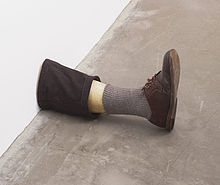In the polymorphous perversity of art,
monogamy is hard to come by. Some artists stick to what they were doing all along, new work following the old like paving stones cutting a path through a garden. Given a compelling initial vision that is not repeated but invented anew each time out, unswerving devotion to an original commitment can be an excellent thing.
Usually, however, art made by any one person changes over time. New attractions and repulsions play a role, sometimes known as the question of influences. If critics tend to make the issue sound straightforward, artists provide a corrective.
 The point of this post is the first quote from Gober, below. I could have posted it by itself, but I succumbed to the temptation to window dress.
The point of this post is the first quote from Gober, below. I could have posted it by itself, but I succumbed to the temptation to window dress.
Robert Gober, via
Whenever I give a talk about my work I am invariably asked who my influences are. Not what my influences are, but who. As if the gutter, misunderstandings, memories, sex, dreams, and books matter less than forebears do. After all, in terms of influences, it is as much the guy who mugged me on Tenth Street, or my beloved dog who passed away much too early, as it was Giotto or Diane Arbus.
Giotto, Arbus or Magritte.
For an artist of Gober’s generation, growing up in the 1960s and 1970s, Magritte was an inescapable presence, visible everywhere on posters and album covers as well as museum walls. Gober’s original ambition was to be a painter rather than a sculptor. “In high school,” he recalls, “I wandered into the Yale Art Gallery. I remember looking at my first Magritte painting–the one of a man in a bowler hat. I thought, ‘I could do that.'”
Years later, when he was preparing an installation for a 1991 exhibition at the Jeu de Paume, in Paris, he remembered Magritte’s 1959 painting State of Grace, which depicts a cigar at the same scale as a bicycle. The centerpiece of his installation became a sculpture of a giant cigar, eight feet long. More recently, when Gober was invited to organize an exhibition in Houston at the Menil Collection by combining his own works with objects from the collection, he included three pictures by Magritte. (more)
Or Duchamp.
Beginning in 1982, Gober executed a series of sinks that became his first “trademark” images. These look as if he might have bought them at a plumbing supply store, much like the one where Marcel Duchamp bought the urinal for his 1917 readymade Fountain. But in fact Gober’s sinks are sculptures, made from plaster over lathing and painted with enamel to simulate the look of porcelain.
In some cases he has altered the shapes of the sinks, but even where they look perfectly “normal” there is something unsettling about them, beginning with the fact that they have no faucets or pipes attached. They are conspicuously nonfunctional in a way that makes us think twice (or three times) about everything they might recall or suggest. (more)



Leave a Reply